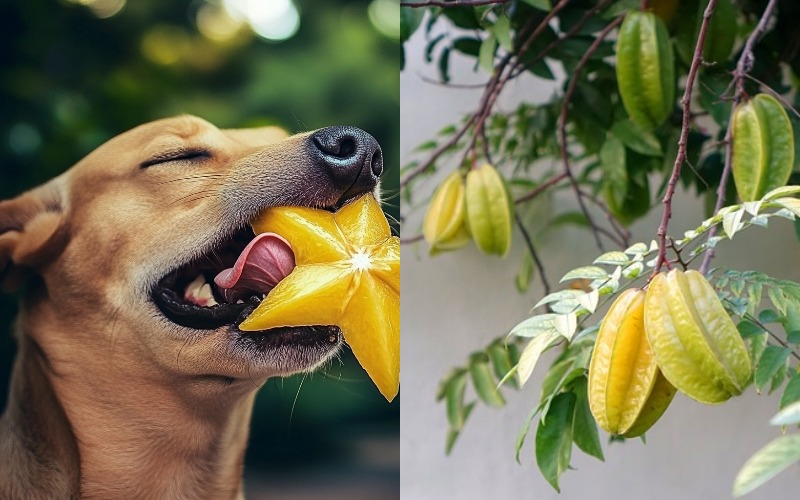Have you ever wondered whether your furry friend can safely indulge in a slice of starfruit? As pet owners, we’re always eager to share our favorite treats with our dogs, but it’s crucial to ensure that these foods are safe for them. Starfruit, also known as carambola, is a tropical fruit with a distinctive star-shaped appearance and a tangy flavor. While it’s a popular choice for human diets due to its vibrant taste and nutritional benefits, it’s essential to determine if this exotic fruit poses any risks to our canine companions.
Featured image by Paresh85 from Pixabay
In this article, we’ll explore whether starfruit is a safe option for dogs to consume. We’ll dive into its potential health benefits and risks, provide expert opinions on its effects on dogs, and offer practical advice on what to do if your pet accidentally consumes starfruit. By the end of this guide, you’ll have a clear understanding of whether starfruit belongs in your dog’s diet and how to make informed decisions about their nutrition.
What Is Starfruit?
In this part of the article we will shortly talk about such topics as what is starfruit (BTW, it is also known as carambola), its appearance, taste, and common uses. Also, we will summarize the key nutrients found in starfruit (vitamins, minerals, antioxidants).

Definition and Description:
Starfruit or carambola is a tropical fruit renowned for its distinctive star-shaped cross-sections and vibrant yellow to green skin. This exotic fruit has a tangy, slightly sweet flavor that makes it a popular addition to fruit salads, juices, and garnishes. Have you ever tried it? We think that yes. Your dog? Maybe yes, or you are just thinking about giving it to your pet.
Nutritional Value:
Nutritionally, starfruit is a powerhouse. It is rich in Vitamin C, which supports immune function and skin health. Additionally, it contains a variety of antioxidants that help combat free radicals, as well as essential minerals like potassium and magnesium. Starfruit also provides dietary fiber, aiding in digestion and promoting overall gut health.
Health Benefits of Starfruit for Humans
Nutritional Benefits:
Starfruit offers a range of health benefits due to its rich nutritional profile. Its high Vitamin C content bolsters the immune system, helps repair tissues, and enhances skin health. The antioxidants in starfruit, such as flavonoids and polyphenols, provide powerful protection against oxidative stress and inflammation, which can contribute to chronic diseases. Additionally, starfruit’s fiber content aids in digestion, helping to prevent constipation and promote a healthy gut. Potassium in starfruit supports cardiovascular health by regulating blood pressure and maintaining fluid balance.
Common Uses:
In human diets, starfruit is a versatile ingredient. It is frequently enjoyed fresh, sliced into star-shaped pieces, and added to fruit salads for a decorative touch and a tangy flavor. Starfruit is also blended into smoothies for a refreshing, tropical twist. Beyond fresh uses, it can be incorporated into savory dishes like salads, or used as a garnish for both sweet and savory recipes. Its unique taste and appearance make it a popular choice for adding visual appeal and a zesty flavor to a variety of dishes.
Is Starfruit Safe for Dogs?

Toxicity Overview:
Starfruit, also known as carambola, is not considered safe for dogs. The fruit contains compounds that can be toxic to canines, especially in larger quantities. Unlike some fruits that are generally safe in moderation, starfruit poses a risk due to its potential to cause harm.
Potential Risks:
The primary concern with starfruit for dogs is its high oxalate content. Oxalates can interfere with calcium absorption and may lead to the formation of kidney stones or exacerbate existing kidney issues. This risk is particularly significant for dogs with pre-existing kidney conditions. Additionally, starfruit contains certain compounds that can be irritating to a dog’s gastrointestinal system, leading to upset stomach or more severe digestive problems.
Symptoms of Toxicity:
If a dog consumes starfruit, pet owners should be vigilant for signs of toxicity. Symptoms may include vomiting, diarrhea, abdominal pain, and lethargy. In more severe cases, if a dog has ingested a significant amount, there may be signs of kidney distress such as increased thirst, frequent urination, or changes in urination patterns. If these symptoms are observed, it is crucial to seek veterinary care promptly.
Veterinary Opinions:
Veterinarians and animal nutritionists generally advise against feeding starfruit to dogs. Experts highlight that the potential risks outweigh any benefits, given the fruit’s potential for causing digestive upset and kidney issues. Most veterinarians would recommend opting for fruits that are known to be safe and beneficial for dogs, such as apples or blueberries, rather than experimenting with less familiar options like starfruit.
What to Do if Your Dog Eats Starfruit
Immediate Actions:
- Assess the Situation:
- Remove Any Remaining Fruit:
- Monitor Your Dog:
- Contact Your Veterinarian:
- Follow Veterinary Advice:
- Keep Records:
Check how much starfruit your dog has consumed. The quantity will help determine the severity of the situation and guide your next steps.
Ensure there is no more starfruit accessible to your dog. This prevents further ingestion and minimizes additional risk.
Keep a close eye on your dog for any immediate signs of distress or illness, such as vomiting, diarrhea, or signs of discomfort.
Reach out to your vet for guidance. Provide them with details about how much starfruit was consumed, your dog’s size and health history, and any symptoms you have observed.
Your vet may recommend inducing vomiting or administering activated charcoal to prevent further absorption of toxins. Follow their instructions precisely.
Document the incident, including the time of consumption and any symptoms your dog exhibits. This information will be useful for your vet.
When to Seek Help
Severe Symptoms:
If your dog shows severe symptoms such as persistent vomiting, diarrhea, lethargy, or signs of kidney distress (increased thirst, frequent urination, or abnormal urination patterns), seek veterinary assistance immediately.
Pre-existing Conditions:
If your dog has a known history of kidney issues or other health concerns, it’s essential to contact your vet as soon as possible to prevent complications.
Large Amount Consumed:
If you suspect your dog has eaten a significant amount of starfruit, do not wait for symptoms to appear. Contact your vet right away for advice on how to manage the situation.
Uncertainty:
If you are unsure about the amount of starfruit ingested or if your dog is displaying any unusual behavior, it’s better to err on the side of caution and consult with a veterinarian.
Safe Alternatives to Starfruit for Dogs
List of Safe Fruits:
- Apples:
- Blueberries:
- Carrots:
- Bananas:
- Watermelon:
- Strawberries:
- Pears:
- Peaches:
Apples are a nutritious and safe option for dogs. Remove the seeds and core before offering them to your pet.
Blueberries are rich in antioxidants and vitamins and make a tasty and healthy treat for dogs.
While not a fruit, carrots are an excellent crunchy snack that is low in calories and high in fiber and vitamins.
Bananas are a good source of potassium and fiber. They should be given in moderation due to their higher sugar content.
Watermelon is hydrating and low in calories. Make sure to remove the seeds and rind before feeding it to your dog.
Strawberries are rich in antioxidants and vitamin C. Serve them in small, bite-sized pieces.
Pears are a good source of fiber and vitamins. Remove seeds and the core before offering them to your dog.
Peaches provide vitamins A and C. Ensure that the pit is removed, as it can be a choking hazard.
Benefits of These Alternatives:
Apples: High in fiber and vitamins A and C, apples promote healthy digestion and boost the immune system. Their crunchy texture can also help clean your dog’s teeth.
Blueberries: Packed with antioxidants, blueberries help combat free radicals, support cognitive function, and contribute to overall health.
Carrots: Carrots are low in calories and high in beta-carotene, which supports vision health and a healthy coat. They also provide a satisfying crunch for dogs to enjoy.
Bananas: Bananas offer potassium for heart and muscle health, and fiber aids in digestion. Their natural sweetness can be a great treat.
Watermelon: Watermelon is hydrating and contains vitamins A, B6, and C. It’s a refreshing treat that helps keep dogs cool and hydrated.
Strawberries: Strawberries are a good source of antioxidants and vitamin C, which can help boost your dog’s immune system and improve skin health.
Pears: Pears provide fiber and vitamins that support digestive health and overall vitality. They are also a low-calorie treat option.
Peaches: Peaches offer vitamins A and C, which are beneficial for the immune system and skin health. Just ensure the pit is removed to prevent choking.
Tips for Safe Feeding Practices
Portion Control:
Moderation Is Key: Fruits should be considered a treat rather than a regular part of your dog’s diet. Aim to offer fruit in small quantities, typically no more than 10% of your dog’s daily caloric intake.
Serving Size: For small dogs, a few small pieces of fruit is generally sufficient. Larger dogs can handle slightly larger portions, but still, keep it moderate. For example, a small apple slice or a few blueberries are appropriate portions for small breeds, while larger dogs can handle a couple of carrot sticks or a few pieces of watermelon.
Frequency: Fruits should be offered as an occasional treat, not a daily staple. Introducing a variety of safe fruits in small amounts ensures that your dog enjoys a balanced diet.
Preparing Fruits:
Wash Thoroughly: Always wash fruits thoroughly to remove any pesticides or contaminants before serving them to your dog.
Remove Seeds and Pits: Ensure all seeds, pits, and cores are removed from fruits. These parts can be harmful or cause choking hazards.
Cut into Small Pieces: Slice fruits into bite-sized pieces appropriate for your dog’s size. This reduces the risk of choking and makes the fruit easier to digest.
Avoid Added Sugars or Sweeteners: Serve fruits in their natural form without added sugars, syrups, or sweeteners, which can be harmful to dogs.
General Fruit Safety Tips:
Introduce Gradually: When introducing a new fruit into your dog’s diet, start with a small amount to monitor for any adverse reactions. This helps to ensure your dog’s digestive system can handle the new food.
Watch for Allergies: Be observant of any signs of allergies or sensitivities such as itching, vomiting, or diarrhea after consuming the fruit. If any of these symptoms occur, discontinue the fruit and consult your veterinarian.
Consult Your Vet: Before making significant changes to your dog’s diet, including introducing new fruits, consult your veterinarian. They can provide personalized advice based on your dog’s health, size, and dietary needs.
Balance with Regular Diet: Ensure that the fruit treats complement your dog’s regular, balanced diet rather than replace it. Fruits should supplement, not substitute, the essential nutrients found in commercial dog food.
Avoid Toxic Fruits: Be aware of fruits that are toxic to dogs, such as grapes and raisins, and never offer them to your pet. Always research or consult your vet if unsure about the safety of a particular fruit.
Summary

In this article, we explored the intriguing topic of whether dogs can safely consume starfruit. We began by understanding what starfruit is, including its nutritional profile and the health benefits it offers to humans. We then examined the safety of starfruit for dogs, noting that while starfruit is generally not recommended due to its potential toxicity and adverse effects, specific risks and symptoms of toxicity were discussed. We provided actionable advice on what to do if your dog eats starfruit and highlighted safe fruit alternatives that are beneficial for canine health. Additionally, we covered essential tips for feeding fruits safely to dogs, ensuring that pet owners can make informed decisions about their dog’s diet.
Final Recommendation
Given the potential risks associated with starfruit, including toxicity and adverse effects, it is advisable to avoid offering starfruit to your dog. Opt for safer fruit options that provide nutritional benefits without the associated risks. Always consult with your veterinarian before introducing new foods into your dog’s diet to ensure their health and safety.
If you found this article helpful, please share it with fellow dog owners to spread awareness about the safety of starfruit and other fruits for dogs. For personalized advice and to discuss your dog’s dietary needs, consult your veterinarian.
FAQs
Can Starfruit Cause Allergies in Dogs?
Yes, starfruit can potentially cause allergic reactions in dogs. Symptoms of an allergy might include itching, swelling, vomiting, or diarrhea. If you suspect your dog is having an allergic reaction, contact your veterinarian immediately for advice and treatment.
Are There Any Benefits to Feeding Starfruit to Dogs?
While starfruit is rich in vitamins and antioxidants for humans, the risks associated with feeding it to dogs outweigh any potential benefits. The potential for toxicity and adverse effects makes it a less favorable choice compared to other safe fruits. Always opt for fruits that are known to be safe and beneficial for dogs.
Additional Resources
American Veterinary Medical Association (AVMA): AVMA – Fruit Safety for Pets
Pet Poison Helpline: Pet Poison Helpline – Fruits Toxic to Dogs
ASPCA Animal Poison Control: ASPCA – Toxic and Non-Toxic Plants
These resources offer valuable information on pet nutrition and safety, helping you make informed choices for your dog’s health.


